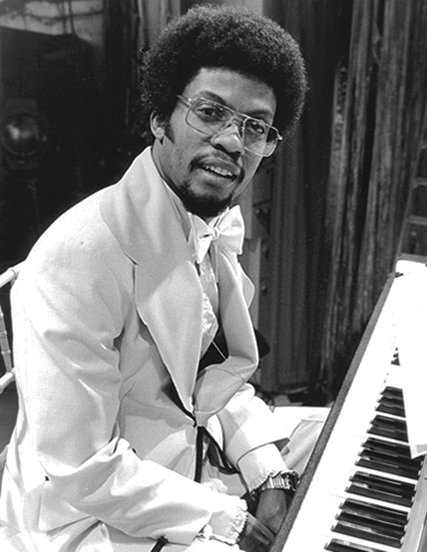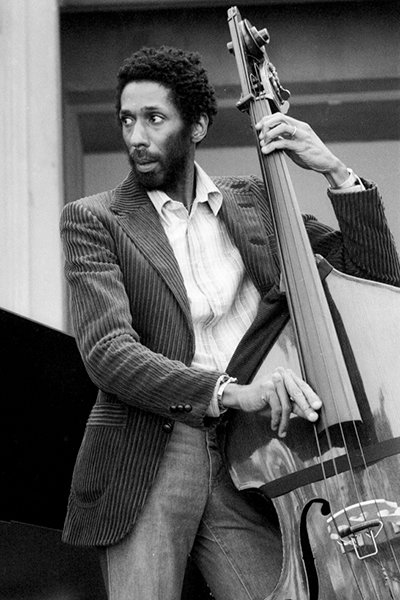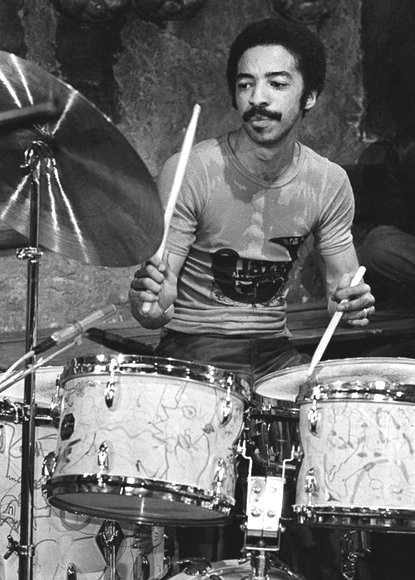Black Comedy
Wayne Shorter (saxo tenor), Miles Davis (trompeta), Herbie Hancock (piano), Ron Carter (contrabajo) y Tony Williams (batería). Extraído del álbum Miles in the Sky (1968) de Miles Davis.
La destreza de la sección rítmica del segundo gran quinteto de Miles Davis se debió a su intuición al seleccionar a sus miembros, que todavía llevaban relativamente poco tiempo en Nueva York. A partir de los 7 años Herbie Hancock estudió música clásica y era considerado un niño prodigio. Durante su adolescencia acompañó a músicos como el saxofonista tenor Coleman Hawkins y el trompetista Donald Byrd, y actuó con sus propios grupos en Chicago, su ciudad natal. Después de graduarse en 1960 se trasladó a Nueva York con el grupo de Byrd y en 1962 grabó para Blue Note Records Takin’ Off, su primer álbum como líder. En él se incluía el tema «Watermelon Man», cuya versión de Mongo Santamaría fue un éxito de ventas. Pero lo más importante es que este trabajo atrajo la atención de Davis, que lo contrató en 1963.
The skill of the rhythm section of Miles Davis’ Second Great Quintet was due to his intuition in selecting his members, who had still been in New York for a relatively short time. From the age of 7 Herbie Hancock studied classical music and was considered a child prodigy. As a teenager he backed musicians such as tenor saxofonist Coleman Hawkins and trumpeter Donald Byrd, and performed with his own groups in his hometown of Chicago. After graduating in 1960 he moved to New York with Byrd’s band and in 1962 recorded for Blue Note Records Takin’ Off, his first album as a leader. It included the theme “Watermelon Man”, whose version of Mongo Santamaría was a bestseller. But most importantly, this work attracted the attention of Davis, who hired him in 1963.

Ron Carter aparece en más de dos mil sesiones de grabación, siendo el contrabajista de jazz más grabado de la historia. Comenzó a estudiar el violonchelo a los diez años, pero los prejuicios raciales le impedían emprender una carrera sinfónica, así que cambió al contrabajo, pero todavía centrado en la música clásica. Cuando terminó sus estudios en 1959 trabajó con el saxofonista alto Cannonball Adderley, el pianista Thelonious Monk y el batería Chico Hamilton, y grabó con el saxofonista alto y flautista Eric Dolphy, el trompetista Don Ellis y el pianista Randy Weston, entre otros. Esto lo convirtió en un técnico experto, un compañero de sección versátil y un sólido solista, lo cual dio lugar a que Davis lo contratara también en 1963.
Ron Carter appears in more than two thousand recording sessions, being the most recorded jazz double bass player in history. He began studying the cello at the age of ten, but racial prejudices prevented him from embarking on a symphonic career, so he switched to double bass, but still focused on classical music. When he finished his studies in 1959 he worked with alto saxofonist Cannonball Adderley, pianist Thelonious Monk and drummer Chico Hamilton, and recorded with alto saxofonist and flutist Eric Dolphy, trumpeter Don Ellis and Randy Weston, among others. This made him an expert technician, a versatile section partner and a solid soloist, which led to Davis recruiting him also in 1963.

Tony Williams comenzó su carrera musical a los 13 años tocando con el saxofonista tenor Sam Rivers y tres años más tarde con el saxofonista alto Jackie McLean, con quien se fue a Nueva York. A los 17 años pasó a ser miembro del grupo de Davis y compensó su falta de experiencia profesional con una gran energía, pasión y creatividad. Tenía un talento excepcional y con el tiempo se convirtió en un virtuoso del instrumento y un explorador nato que experimentaba con todo aquello que inspirara sus inquietudes musicales. Junto con Hancock y Carter se embarcaba en un complejo diálogo polirrítmico. Su música tenía una expresión moderada e insinuaciones; un sendero escondido en la maleza en lugar de una autopista. Sin embargo, Williams también sabía impulsar el grupo con un ritmo sólido e inspirado cuando el sonido era más abierto.
Tony Williams began his musical career at the age of 13 playing with tenor saxofonist Sam Rivers and three years later with alto saxofonist Jackie McLean, with whom he went to New York. At the age of 17 he became a member of Davis’ group and made up for his lack of professional experience with great energy, passion and creativity. He was exceptionally talented and eventually became a virtuoso of the instrument and a natural explorer who experimented with everything that inspired his musical interests. Together with Hancock and Carter he embarked on a complex polyrhythmic dialogue. Their music had a moderate expression and insinuations; a path hidden in the brush instead of a highway. However, Williams also knew hot to push the band forward with a solid and inspired rhythm when the sound was more open.

El tema es corto y animado, con Shorter y Davis tocando al unísono. De inmediato Davis comienza a tocar de forma imparable y contundente a una velocidad de vértigo con Williams impulsándolo con vitalidad, aunque a veces disminuye el paso. Le sigue Shorter con un solo igualmente impetuoso, aunque introduciendo silencios entre las frases y haciendo malabarismos, mientras Hancock lo anima de forma estimulante por detrás. A continuación llega Hancock con una línea melódica intrépida y meteórica golpeando la teclas con fuerza y la composición termina con Shorter y Davis tocando una frase dos veces.
The theme is lively and short, with Shorter and Davis playing in unison. Immediately Davis begins to play unstoppable and strongly at a dizzying speed with Williams pushing him with vitality, although occasionally he slows down. Shorter follows him with an equally impetuous solo, though introducing silences between the phrases and juggling, while Hancock encourages him in a stimulating way below. Next comes Hancock with an intrepid and meteoric melodic line hitting the keys hard and the composition ends with Shorter and Davis playing a phrase twice.

Translated with the help of DeepL

Country Son
Wayne Shorter (saxo tenor), Miles Davis (trompeta), Herbie Hancock (piano), Ron Carter (contrabajo) y Tony Williams (batería). Extraído del álbum Miles in the Sky (1968) de Miles Davis.
En esta composición no hay tema, es muy rápido y entra todo el grupo de golpe excepto Shorter. Davis lo hace realizando un solo directamente; utiliza pocas notas, pero también introduce frases frenéticas. A veces Williams interviene con grandes estruendos. De repente la interpretación se pacifica y se vuelve a animar, pero esta vez a tiempo medio. Luego entra Shorter con un discurso pausado y meditado mientras Williams toca a un gran volumen. En un momento determinado, Carter introduce el walking y Shorter se adapta a la nueva velocidad tocando de forma moderada y convencional, aunque luego acelera su actuación impulsado por Williams. A continuación vuelve la calma como en una ensoñación y se queda sola la sección rítmica. Carter cambia el ritmo y Hancock comienza a hacer un solo equilibrado y sereno. Entonces, Carter vuelve a introducir el walking y Hancock sigue disfrutando de su narración musical. Llega de nuevo la tranquilidad y entra Davis aumentando la rapidez y haciendo un segundo solo coherente y bien articulado. Carter vuelve a introducir el walking mientras Davis continúa tocando, pero esta vez se vuelve atrevido y trepidante empujado por Hancock y Williams; y para concluir, el grupo se apacigua y todos dejan de tocar.
In this composition there is no theme, it’s very swift and the whole group enters at once except Shorter. Davis does it by making a solo directly; he uses few notes, but also introduces frantic phrases. Sometimes Williams steps in with loud thunder. All of a sudden the interpretation is pacified and cheered up again, but this time at medium tempo. Then Shorter comes in with a paused and meditative speech while Williams plays at a large volume. At a certain point, Carter introduces walking and Shorter adapts to the new speed playing in a moderate and conventional way, although he then accelerates his rendition driven by Williams. Next the calm returns as if in a dream and the rhythm section is left alone. Carter changes the pace and Hancock begins to make a balanced and serene solo. After that, Carter reintroduces walking and Hancock continues to enjoy his discourse. Here comes the calm again and Davis enters increasing the speed and making a second solo coherent and well articulated. Carter reintroduces walking while Davis continues playing, but this time he becomes daring and fast-paced pushed by Hancock and Williams; and to conclude, the group calms down and everyone stops playing.
℗ Columbia Records

